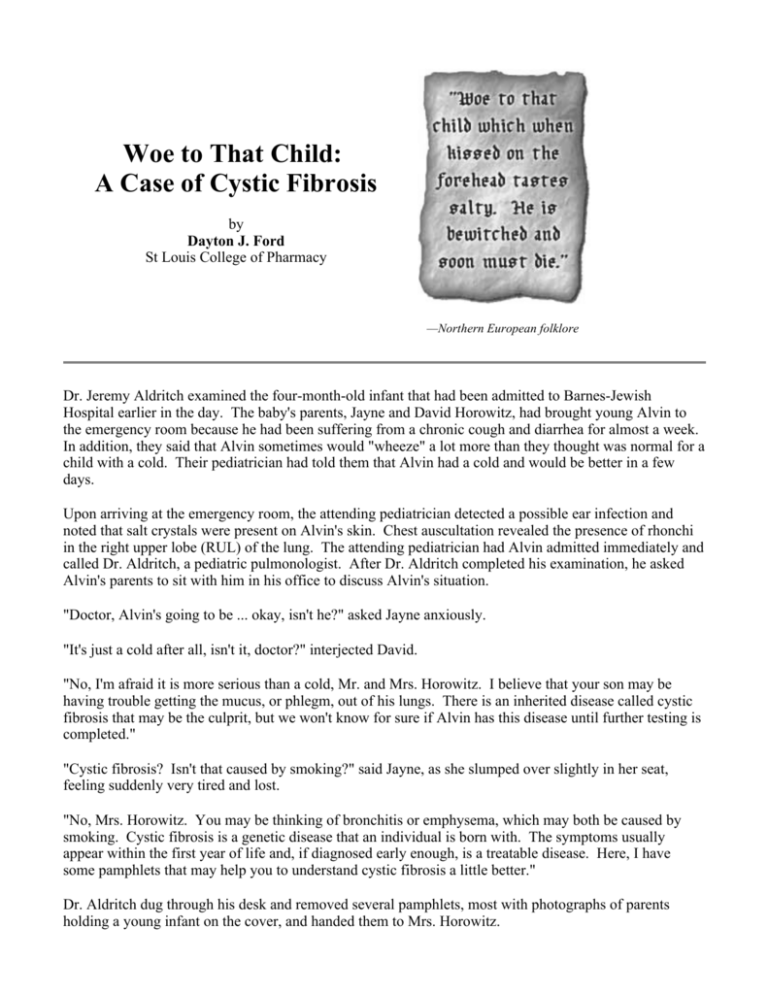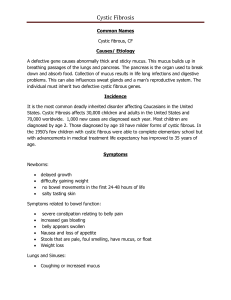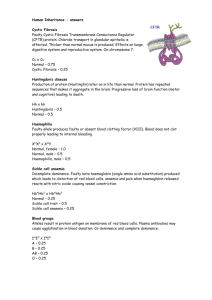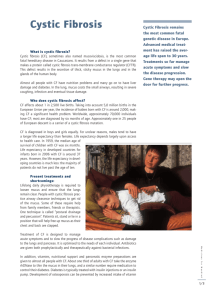Woe to That Child: A Case of Cystic Fibrosis
advertisement

Woe to That Child: A Case of Cystic Fibrosis by Dayton J. Ford St Louis College of Pharmacy —Northern European folklore Dr. Jeremy Aldritch examined the four-month-old infant that had been admitted to Barnes-Jewish Hospital earlier in the day. The baby's parents, Jayne and David Horowitz, had brought young Alvin to the emergency room because he had been suffering from a chronic cough and diarrhea for almost a week. In addition, they said that Alvin sometimes would "wheeze" a lot more than they thought was normal for a child with a cold. Their pediatrician had told them that Alvin had a cold and would be better in a few days. Upon arriving at the emergency room, the attending pediatrician detected a possible ear infection and noted that salt crystals were present on Alvin's skin. Chest auscultation revealed the presence of rhonchi in the right upper lobe (RUL) of the lung. The attending pediatrician had Alvin admitted immediately and called Dr. Aldritch, a pediatric pulmonologist. After Dr. Aldritch completed his examination, he asked Alvin's parents to sit with him in his office to discuss Alvin's situation. "Doctor, Alvin's going to be ... okay, isn't he?" asked Jayne anxiously. "It's just a cold after all, isn't it, doctor?" interjected David. "No, I'm afraid it is more serious than a cold, Mr. and Mrs. Horowitz. I believe that your son may be having trouble getting the mucus, or phlegm, out of his lungs. There is an inherited disease called cystic fibrosis that may be the culprit, but we won't know for sure if Alvin has this disease until further testing is completed." "Cystic fibrosis? Isn't that caused by smoking?" said Jayne, as she slumped over slightly in her seat, feeling suddenly very tired and lost. "No, Mrs. Horowitz. You may be thinking of bronchitis or emphysema, which may both be caused by smoking. Cystic fibrosis is a genetic disease that an individual is born with. The symptoms usually appear within the first year of life and, if diagnosed early enough, is a treatable disease. Here, I have some pamphlets that may help you to understand cystic fibrosis a little better." Dr. Aldritch dug through his desk and removed several pamphlets, most with photographs of parents holding a young infant on the cover, and handed them to Mrs. Horowitz. 2 "Is this fatal, doctor? I mean, our son isn't going to, to ...." David couldn't finish the thought. "No, no, your son will be fine for now, there is no immediate danger. Cystic fibrosis, or CF for short, is a serious enough disease, but it is not fatal in the short term and there are treatments that can help your son to live a relatively normal and healthy life. You see, what has happened is that Alvin was born with this disease, caused by a faulty gene within his DNA, and it has just now begun to show itself. The coughing that you were initially concerned about occurs in those who have CF because their lungs are filled with mucus. You see, normally your lungs produce a slightly viscous, more fluid type of mucus that acts to trap debris and dust particles so that they may be swept out of the lungs. This system helps to keep the air passages clear. In children with CF, however, the mucus that is secreted into the lungs is more viscous and less fluid, or contains less water than normal; therefore, it tends to clog the air passages and triggers a coughing reflex in order to expel the mucus from the lungs." "You said that there are treatments, doctor, but is there a cure? How long will Alvin have to live like this?" Jayne asked. "I'm afraid that there is no cure yet, Mrs. Horowitz. There are some clinical trials being conducted on various treatments for the disease, but the only real cure for a genetically inherited disease is gene therapy. Right now many scientists around the world are trying to develop methods to replace faulty or abnormal genes with copies of normal genes. We haven't yet reached the level of sophistication required to do this, but I believe that within Alvin's lifetime we just may. I know that you have a lot more questions, but I want you to rest assured that your son will be OK. I am going to go check on Alvin and see how soon the lab results will be ready. While I am gone, I will have a group of staff pharmacists answer all of your questions about CF." In order to give Mr. and Mrs. Horowitz the correct answers to their questions, you will need to know the answers to the questions listed below. Remember that Mr. and Mrs. Horowitz consider you to be the experts on how their son got CF, what it does (e.g., what is its mechanism of action) and what treatment options are available for their son Alvin. Be sure to be thorough and professional in your preparation. Questions: 1. What do scientists currently believe is the cause of CF? In other words, how is the faulty gene inherited and what direct effect does that have on the affected cells? 2. Draw a flow chart/concept map that illustrates the mechanism whereby the faulty CF gene causes the production of thick mucus with less water in it than normal. 3. What specific part of the cell/structure allows the mucus secretions to be thick and viscous rather than fluid (i.e., is it a membrane channel, organelle or something else)? Please be specific and describe the step-by-step mechanism whereby this altered structure/part of the cell causes the secretions to contain less water. 4. Why does Alvin have salt crystals forming on his skin? Explain the mechanism for this. 5. What is the accepted treatment for children with cystic fibrosis? Make sure to list at least three and explain why they work (i.e., what is the purpose of each individual treatment). 6. List and explain the mechanism of at least two experimental treatments that are currently being tried to help patients with cystic fibrosis. 7. Briefly describe how gene therapy may help cure a genetically inherited disease like cystic fibrosis. Date Posted: 03/17/03 nas




